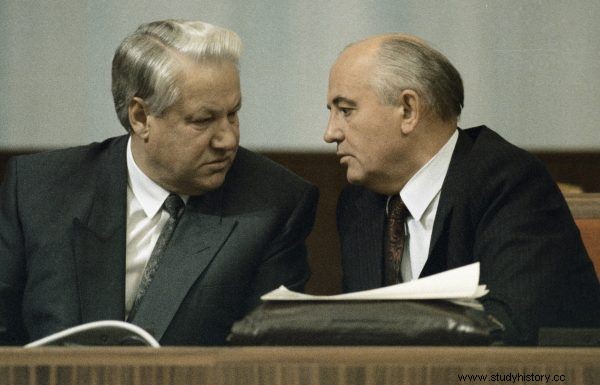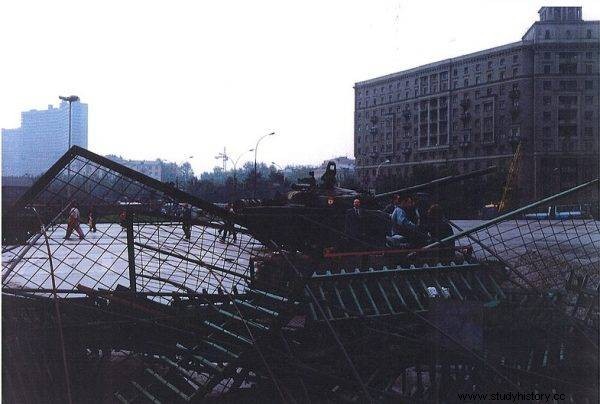On August 19, 1991, a group of hard-line apparatchiks attempted to seize power in the Soviet Union in an attempt to stop the country's disintegration. The attempt to save the old order failed and led to the collapse of the USSR.
The August coup owed its failure above all to the Muscovites who flocked to the streets of the Soviet capital. In this way, the citizens demonstrated their opposition to the actions of the putschists and the return to the communist dictatorship. These were people who - as a result of Gorbachev's perestroika - got to know the sweet taste of freedom and did not want to find themselves behind the Iron Curtain again.
The coup is maturing…
The perestroika policy announced by the 54-year-old secretary general of the CPSU Central Committee, Mikhail Gorbachev, quickly paid off. Free press appeared in the country. People hungry for the truth about their country's past and its problems at that time lined up in long lines in front of the kiosks. The inhabitants realized that their civil rights were being violated and wanted to live as in the "rotten West".
Citizens and politicians increasingly demanded the lifting of the hegemony of the Communist Party. In 1989 - for the first time in 80 years - non-party members entered the Supreme Soviet of the Soviet Union as a result of free elections. Opposition factions appeared in the Soviet parliament, for example the Interregional Group of Deputies.

The perestroika policy announced by the 54-year-old secretary general of the CPSU Central Committee, Mikhail Gorbachev, quickly paid off.
All this was not to the taste of the conservatives, which were not lacking in Gorbachev's surroundings - the Soviet leader was forced to maneuver between the supporters of the old order and representatives of democratic groups. The Baltic Republics declared their intention to leave the Soviet Union. Anyway, one gets the impression that the initiator of perestroika, intending to build "socialism with a human face", was surprised by the scope of changes that took place in the country and in the minds of its citizens.
At the end of 1990, the Conservatives began to exert more and more influence over Gorbachev, who in March 1990 became the first President of the USSR. Eduard Shevardnadze, Minister of Foreign Affairs of the Soviet Union, resigned on December 21, 1990, explaining that it was his protest against "the coming dictatorship." On January 13, 1991, Soviet tanks attacked the Vilnius TV tower. 14 defenders of the building were killed. On January 29 of the same year, Gorbachev allowed the use of the army "in order to maintain public order."
Restart of the Soviet Union
The social situation in the country was not easy. Not only the Baltic Republics, but even the Ukrainian Soviet Socialist Republic - obviously influenced by public opinion - began to demand greater independence from Moscow. Boris Yeltsin, the main political rival of the Secretary General of the Central Committee of the CPSU, enjoyed great popularity and in June 1991 he won the presidential elections in Russia.
To save the Soviet Union from final disintegration, Mikhail Gorbachev decided to renegotiate the union treaty. Nine republics were to join the new state called the "Union of Soviet Sovereign Republics" :Russia, Ukraine, Belarus, Kazakhstan, Turkmenistan, Uzbekistan, Tajikistan, Kyrgyzstan, Azerbaijan. The remaining members of the USSR were allowed to enter this structure in the future. As expected, Lithuania, Latvia and Estonia withdrew their membership in the Union of Soviet Sovereign Republics.
It was agreed that the entities of the new state would enjoy greater independence from Moscow, while maintaining a common currency and common armed forces. Mikhail Gorbachev remained as president. The signing of the new treaty was scheduled for August 20, 1991, when the leaders of the nine republics were to come to Moscow. Having made arrangements for a new union agreement. Gorbachev, his wife Raisa, daughter Irina, son-in-law Anatoly and their two daughters went on vacation to their Crimean residence in Foros. They planned their return to the capital on August 19…
The coup and its fiasco
The hardliners in the Soviet authorities decided not to allow the treaty to be signed and to refrain from introducing any reforms. For this purpose, they founded the so-called State Committee of the Emergency State (PKSW). It was composed of eight people, incl. Prime Minister Valentin Pavlov, Deputy President of the USSR Gennady Yanaev, Minister of Defense of the USSR Dmitry Yazov, head of the KGB Vladimir Kriuczkov, Minister of the Interior Boris Pugo. The plan was to introduce a state of emergency and overthrow Mikhail Gorbachev.
On August 18, members of PKSW visited the President of the USSR to persuade him to resign from his function. The reason for this was poor health that made it impossible to perform the duties of the head of state. Mikhail Gorbachev did not agree. Then the conspirators gave the order to intern the president. The Foros residence has been cut off from the telephone.

In the evening, protests began in the streets of Moscow.
August 19 on Monday at 3:30 the head of the KGB announced to his subordinates:"Perestroika is over" . At. At 5:00 the head of the Moscow branch of the KGB received from his management signed blank forms of arrest warrants (the putschists planned the arrest of their political opponents, journalists, etc.).
At. At 6.00 a.m. at a press conference transmitted by television and radio, Gennady Janajew spoke on behalf of the PKSW. Mikhail Gorbachev was unable to fulfill his constitutional duties due to ill health, he said. For the time of the president's indisposition, he was to be replaced by the vice-president. Janajew announced the introduction of a state of emergency, called on citizens to "remain calm" and submit to the decisions of the new authorities . After hearing Janjew's statement, a young journalist asked the members of PKSW:"Do you realize that you have just committed a coup?".
In the early morning of August 19, the putschists brought several elite military units to the capital. An interesting fact is that the commanders of some formations refused to obey the members of the PKSW. In the evening, protests began in the streets of Moscow. Dissatisfied, they went to the White House - the seat of the Russian parliament - which became the center of the opposition. The protesters were headed by Boris Yeltsin. Duma deputies, cultural and military activists who did not want to submit to the PKSW gathered in the building. The White House was surrounded by tank troops loyal to Yeltsin, intending to defend opposition politicians. At one point, Yeltsin climbed up on one of the tanks, gave a speech and described the actions of the putschists as "unlawful".
In the evening of August 20, people in the White House received news that loyal to the putschists military units are to attack the building on the night of August 20-21 . The people of Moscow built barricades around the seat of parliament. President Yeltsin and vice-president Alexander Ruckoy asked people not to risk their lives and not to lie under the wheels of oncoming tanks. Instead, they advised them to talk to the attackers and appeal to their conscience. There was indeed an attack that night. During it, three young Muscovites were killed.
In the morning of August 21, it became clear that the coup was slowly dying out. It happened thanks to the protests of citizens and the indecision of the members of PKSW. In the evening the arrests of putschists began, one of them - Boris Pugo - committed suicide. On the night of August 21-22, Gorbachev and his family returned to Moscow.
